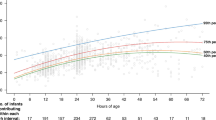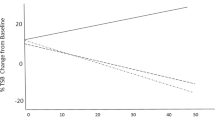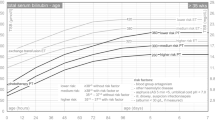Abstract
Background
Despite widespread phototherapy usage, many new-born infants remain in need of other invasive lines of therapy, such as intravenous immunoglobulins and exchange transfusions.
Objective
Assessment of the efficacy and the safety of adding fenofibrate to phototherapy for the treatment of pathological jaundice in full-term infants.
Design/methods
We conducted a double blinded randomized control study on 180 full-term infants with pathological unconjugated hyperbilirubinemia admitted to the NICU at Mansoura University Children’s Hospital. They were randomly assigned to receive either oral fenofibrate 10 mg/kg/day for 1 day or 2 days or placebo in addition to phototherapy. The primary outcome was total serum bilirubin values after 12, 24, 36, 48, and 72 h from intervention. Secondary outcomes were total duration of treatment, need for exchange transfusions and intravenous immunoglobulin, exclusive breast-feeding on discharge, and adverse effects of fenofibrate. This study was registered at www.clinicaltrials.gov (NCT04418180).
Results
A total of 180 full-term infants were included, 60 in each group. Infants in group I and II showed significant reduction of bilirubin levels at 36, 48, and 72 h from intervention compared to group III, respectively. Fenofibrate administration was associated with significantly shorter duration of phototherapy, shorter hospital stay, and higher frequency of exclusive breast-feeding compared to phototherapy alone.
Conclusion(s)
Fenofibrate as an adjuvant to phototherapy in term neonate with pathological jaundice is well tolerated and associated with significant reduction of serum bilirubin levels, a shorter duration of phototherapy, shorter hospital stay and higher frequency of exclusive breast-feeding, without significant adverse effects in either the single or double dosage.
This is a preview of subscription content, access via your institution
Access options
Subscribe to this journal
Receive 12 print issues and online access
$259.00 per year
only $21.58 per issue
Buy this article
- Purchase on Springer Link
- Instant access to full article PDF
Prices may be subject to local taxes which are calculated during checkout

Similar content being viewed by others
References
Waite WM, Taylor JA. Phototherapy for the treatment of neonatal jaundice and breastfeeding duration and exclusivity. Breastfeed Med. 2016;11:180–5.
Olusanya BO, Teeple S, Kassebaum NJ. The contribution of neonatal jaundice to global child mortality: findings from the GBD 2016 Study. Pediatrics. 2018;141:e20171471.
Zhang L. Severe neonatal hyperbilirubinemia induces temporal and occipital lobe seizures. PLoS ONE. 2018;13:e0197113.
Sgro M, Campbell DM, Kandasamy S, Shah V. Incidence of chronic bilirubin encephalopathy in Canada, 2007-8. Pediatrics. 2012;130:e886–90.
Al-Asy H, El-Sharkawy H, Mabrouk M, Hamad M. Effect of fenofibrate on indirect neonatal hyperbilirubinemia. J Clin Neonatol. 2015;4:82.
Mreihil K, Benth JŠ, Stensvold HJ, Nakstad B, Hansen TWR, Scheck O, et al. Phototherapy is commonly used for neonatal jaundice but greater control is needed to avoid toxicity in the most vulnerable infants. Acta Paediatr Int J Paediatr. 2018;107:611–9.
American Academy of Pediatrics Subcommittee on Hyperbilirubinemia. Management of hyperbilirubinemia in the newborn infant 35 or more weeks of gestation. Pediatrics. 2004;114:297–316.
Cortey A, Elzaabi M, Waegemans T, Roch B, Aujard Y. Efficacité et tolérance des immunoglobulines polyvalentes dans l’hyperbilirubinémie néonatale par incompatibilité ABO. Méta-analyse. Arch Pediatr. 2014;21:976–83.
Ree IMC, Smits-Wintjens VEHJ, van der Bom JG, van Klink JMM, Oepkes D, Lopriore E. Neonatal management and outcome in alloimmune hemolytic disease. Expert Rev Hematol. 2017;10:607–16.
Bülbül A, Okan FF, Kabakoǧlu Ünsür E, Nuhoǧlu A. Adverse events associated with exchange transfusion and etiology of severe hyperbilirubinemia in near-term and term newborns. Turkish J Med Sci. 2011;41:93–100.
Giampietro L, Ammazzalorso A, Amoroso R, De, Filippis B. Development of fibrates as important scaffolds in medicinal chemistry. ChemMedChem. 2019;14:1051–66.
Cindoruk M, Kerem M, Karakan T, Salman B, Akin O, Alper M, et al. Peroxisome proliferators-activated alpha agonist treatment ameliorates hepatic damage in rats with obstructive jaundice: an experimental study. BMC Gastroenterol. 2007;7:44.
Gholitabar M, McGuire H, Rennie J, Manning D, Lai R. Clofibrate in combination with phototherapy for unconjugated neonatal hyperbilirubinaemia. Cochrane Database Syst Rev. 2012;12:CD009017.
Chaudhary GS, Chaudhary V, Chaurasiya OS, Chandrakant V, Kumar V. Oral fenofibrate in neonatal hyperbilirubinemia: a randomized controlled trial. Indian J Child Health. 2016;03:54–8.
Goldberg AC, Schonfeld G, Feldman EB, Ginsberg HN, Hunninghake DB, Insull W, et al. Fenofibrate for the treatment of type IV and V hyperlipoproteinemias: a double-blind placebo-controlled multicenter US study. Clin Ther. 1989;11:69–83.
Brown WV, Dujovne CA, Farquhar JW, Feldman EB, Grundy SM, Knopp RH, et al. Effects of fenofibrate on plasma lipids. Double-blind, multicenter study in patients with Type IIA or IIB hyperlipidemia. Arteriosclerosis. 1986;6:670–8.
Kumar B, Agarwal P, Chorishi A, Dhaneria M. Fenofibrate: a novel approach in treating uncomplicated neonatal hyperbilirubinemia? People’s J Sci Res. 2012;5:5–8.
McGowan MW, Artiss JD, Strandbergh DR, Zak B. A peroxidase-coupled method for the colorimetric determination of serum triglycerides. Clin Chem. 1983;29:538–42.
Zeevenhooven J, Koppen IJN, Benninga MA. The new Rome IV criteria for functional gastrointestinal disorders in infants and toddlers. Pediatr Gastroenterol Hepatol Nutr. 2017;20:1–13.
Wan A, Mat Daud S, Teh SH, Choo YM, Kutty FM. Management of neonatal jaundice in primary care. Malays Fam physician J Acad Fam Physicians Malays. 2016;11:16–9.
Itoh S, Okada H, Kuboi T, Kusaka T. Phototherapy for neonatal hyperbilirubinemia. Pediatr Int. 2017;59:959–66.
Magai DN, Mwaniki M, Abubakar A, Mohammed S, Gordon AL, Kalu R, et al. A randomized control trial of phototherapy and 20% albumin versus phototherapy and saline in Kilifi, Kenya. BMC Res Notes. 2019;12:617.
Maimburg RD, Olsen J, Sun Y. Neonatal hyperbilirubinemia and the risk of febrile seizures and childhood epilepsy. Epilepsy Res. 2016;124:67–72.
Newman TB, Wickremasinghe AC, Walsh EM, Grimes BA, McCulloch CE, Kuzniewicz MW. Retrospective cohort study of phototherapy and childhood cancer in Northern California. Pediatrics. 2016;137:e20151354–e20151354.
Hamidi M, Zamanzad B, Mesripour A. Comparing the effect of clofibrate and phenobarbital on the newborns with hyperbilirubinemia. EXCLI J. 2013;12:75–8.
Fallah R, Islami Z, Lotfi SR. Single dose of 50 mg/kg clofibrate in jaundice of healthy term neonates: randomised clinical trial of efficacy and safety. Indian J Pediatr. 2012;79:194–7.
Sharafi R, Mortazavi Z, Sharafi S, Parashkouh RM. The effect of clofibrate on decreasing serum bilirubin in healthy term neonates under home phototherapy. Iran J Pediatr. 2010;20:48–52.
Sakha SH, Gharehbaghi M, Rahbani M. The effect of clofibrate with phototherapy in late pre-term newborns with non-hemolytic jaundice. Indian J Med Sci. 2009;63:174–9.
Habibi M, Mahyar A, Ayazi P, Ahmadabadi F, Javadi A. The effect of clofibrate on hyperbilirubinemia of term neonates. Acta Med Iran. 2012;50:21–5.
Ahmadpour-kacho M, Zahed Pasha Y, Moghadamnia AA, Khafri S, Vafaeinezhad M. The effect of oral fenofibrate on serum bilirubin level in term neonates with hyperbilirubinemia: a randomized clinical trail. Int J Pediatr. 2018;6:8317–27.
Al-Banna S, Riad A, Anes S. The effect of fenofibrate and antioxidant vitamins [D, E and C] in treatment of uncomplicated neonatal hyperbilirubinemia. Ann Neonatol J. 2019;2:37–48.
El-Frargy M, El-Sharkawy H, Attia G. Therapeutic difference in some treatment modalities of jaundice in Egyptian neonates. J Clin Neonatol. 2016;5:162.
Anantha Narayana Gowda BL, Professor A, Karnataka D. Efficacy of oral fenofibrate in the management of unconjugated hyperbilirubinemia in neonates prospective study. Sci Technol. 2014;13:253.
Author information
Authors and Affiliations
Contributions
MHA shared in the statistical analysis of the study, initial manuscript, and approved the final manuscript. SA shared in study design, recruitment of patients, collection of the data, statistical analysis of the study, and approved the final manuscript. MH shared in the study design, manuscript revision, and approved the final manuscript. IN shared in the study design, collection of data, adjustment of references, manuscript revision, and approved the final manuscript. AS shared in hypothesis formulation, study design, critically reviewed and revised the manuscript, and approved the final manuscript.
Corresponding author
Ethics declarations
Conflict of interest
The authors declare that they have no conflict of interest.
Additional information
Publisher’s note Springer Nature remains neutral with regard to jurisdictional claims in published maps and institutional affiliations.
Rights and permissions
About this article
Cite this article
Awad, M.H., Amer, S., Hafez, M. et al. “Fenofibrate as an adjuvant to phototherapy in pathological unconjugated hyperbilirubinemia in neonates: a randomized control trial.”. J Perinatol 41, 865–872 (2021). https://doi.org/10.1038/s41372-020-00861-2
Received:
Revised:
Accepted:
Published:
Issue Date:
DOI: https://doi.org/10.1038/s41372-020-00861-2



